Korg Nautilus 61 61-key Synthesizer Workstation
₹250,000.00 Original price was: ₹250,000.00.₹215,000.00Current price is: ₹215,000.00.
System, Keyboard
- System
- NAUTILUS System Version 1.0
- Keyboard
- 88 key: RH3 (Real Weighted Hammer Action 3), A – C
73 key: Natural Touch Semi Weighted, C – C
61 key: Natural Touch Semi Weighted, C – C
Velocity sensitive is supported, after touch is not supported.
Tone Generator
- Synthesis Types
- 9
SGX-2: Premium Piano (Acoustic Piano)
EP-1: MDS Electric Piano (Electric Piano)
HD-1: High Definition Synthesizer (PCM)
AL-1: Analog Synthesizer (Analog Modeling)
CX-3: Tonewheel Organ (Tonewheel Organ Modeling)
STR-1: Plucked String (Physical Modeling)
MOD-7: Waveshaping VPM Synthesizer (VPM Synthesis)
MS-20EX: Component Modeling Technology (Analog Modeling)
PolysixEX: Component Modeling Technology (CMT Analog Modeling)
- Maximum Polyphony*1*2
- SGX-2: 100 voices*3
EP-1: 104 voices
HD-1: 140 voices
AL-1: 80 voices
CX-3: 200 voices
STR-1: 40 voices
MOD-7: 52 voices
MS-20EX: 40 voices
PolysixEX: 180 voices1: In rare cases, when a large number of processor-intensive effects are active simultaneously (for instance, more than 14 O-Verbs), polyphony may be slightly reduced.
*2: A portion of the multicore processor in NAUTILUS is devoted to generating voices, and a separate portion is devoted to generating effects. NAUTILUS dynamically allocates the voice processing power between the engines as necessary. The quoted maximum numbers of voices apply when 100% of the voice processing power is devoted to a single engine.
*3: 100 dual-stereo notes (equivalent to 400 mono voices)
- Preset PCM
- RAM 496 MB / DISK 2.3G (ROM 1,771 Multisamples, 3,955 Drumsamples)
- Build-in Expansion PCM Libraries
- EXs301: German2 D Piano
EXs302: Italian F Piano
EXs303: Japanese Upright U Piano
EXs304: Prepared Piano
EXs305: Historical Keyboards
EXs306: Vintage Keyboards 2
EXs307: Strings & Synths
EXs308: Guitar Collection
EXs309: Bass Collection
EXs310: World Essence
EXs311: Background Loops
EXs312: SFX & Hits
EXs313: Found Percussions
EXs314: Expansion Drums
- PCM RAM Capacity
- Approx. 2GB *4
*4: The memory available for Sampling Mode will change based on the use of Expansion PCM libraries and User Sample Banks. Approx. 260 MB is available when shipped from the factory (When loading the file named “PRELOAD.KSC”).
- Wave Sequences
- 598 User memory, 377 Preload
Support for stereo multisamples, synchronization of individual notes, and tempo-based settings.
SGX-2 Program
- Premium Piano
- Full key stereo sampling, Chromatically sampled at up to 12 velocity levels, no looping.
Damper resonance and mechanical noise are reproduced.
Una Corda sample support
- PCM
- EXs301 – German2 D Piano
12 velocity levels, includes Ambience Piano type/samplesEXs302 – Italian F Piano
12 velocity levels, no Una Corda samplesEXs303 – Japanese Upright U Piano
8 velocity levelsExs304 – Prepared Piano
1-4 velocity levels
- Piano Type
- 128
(With the factory settings, the 64 varieties of EXs6: German D Piano, EXs7: Japanese C Piano, EXs12: SGX-1 Austrian D Piano, EXs17: Berlin D Piano do not produce sound. The options must be downloaded. (Those will be released at a later date.))
- Oscillator Control
- Damper Resonance
Damper Noise
Mechanical Noise
Note Release
String Resonance
Una Corda
EP-1 Program
- MDS Electric Piano
- Tine and reed-type electric pianos powered by Multi-Dimensional Synthesis (MDS), and vintage effects.
- Electric Piano Model Types
- 7
Tine EP I Early, Tine EP I Late, Tine EP II, Tine EP V, Tine EP DMP, Reed EP200, Reed EP200A
- Oscillator Control
- Harmonic Sound Level, Attack Noise, Level, Release Noise Level, Attack Brightness, Hammer Width
- Panel Control
- Tine Type
Preamp Volume, Tone (Treble, Bass), Vibrate (On/Off, Intensity, Speed), Amp/Cabinet (On/Off, Drive)Reed Type
Preamp Volume, Tone (Treble, Bass), Vibrate (Intensity, Speed), Amp/Cabinet (On/Off, Drive)
- Effect Types
- 9
Small Phase, Orange Phase, Black Phase, Vintage Chorus, Black Chorus, EP Chorus, Vintage Flanger, Red Comp, VOX Wah
HD-1 Program
- Advanced Vector Synthesis
- Control oscillator volumes and synthesis & effects parameters via the Vector Joystick and the tempo-synchronized Vector Envelope.
- Structure
- Single: only OSC1, Double: OSC1 and OSC2.
Double mode lets you layer two completely separate synth voices, each with their own velocity-switched oscillator, dual filter, EGs, LFOs, etc.
Drums: One drum kit, Double Drums: Two drum kits.
- Oscillators
- 8 velocity zones per oscillator, with switching, crossfades and layering
Each zone can play mono or stereo Multisamples or Wave Sequences
- Filters
- Two multi-mode filters per voices (low-pass, high-pass, band-pass and band-reject), Four-mode filter routings (single, serial, parallel and 24dB mode)
- Driver
- Per voice non-linear driver and low boost circuit
- EQ
- Three bands, with sweep-able mid
- Modulation
- Three envelope generators, two LFOs per voice, common LFO, four key tracking generators, AMS (Alternate Modulation Source), two AMS mixers
- Quick Layer / Split function
EXi Program Common
- Advanced Vector Synthesis
- Control oscillator volumes and synthesis & effects parameters via the Vector Joystick and the tempo-synchronized Vector Envelope
- Modulation
- Common Step Sequencer, AMS (Alternate Modulation Source), Common LFO, 2 Key Tracking Generators
- EQ
- Three bands, with sweep-able mid
- Quick Layer / Split function
AL-1 Program
- Oscillators
- Ultra-low-aliasing oscillators, OSC1, OSC2, Sub-oscillator and noise generator; ring modulation, FM and Sync
- Audio Input
- External audio can be processed through the ring modulator, filter, driver, amp, and EQ
- Filters
- Two multi-mode filters (low-pass, high-pass, band-pass and band-reject) with four types of filter routings (single, serial, parallel and 24dB mode), Multi Filter mode (only Filter-A; modulatable mix of Low Pass, High Pass, Band Pass, and dry input, for creating a wide variety of unique filter types and effects)
- Driver
- Per-voice non-linear driver and low boost circuit
- Modulation
- Five Envelope generators, four per-voice LFOs, two AMS Mixers; Per-voice Step Sequencer
CX-3 Program
- Tonewheel Organ Modeling
- Phase-synchronous tonewheels (clean and vintage modes), percussion, key click, wheel brake
- EX Mode
- Four additional, user-specified drawbars, and expanded percussion
- Internal Effects
- Rotary speaker, vibrato/chorus, amp modeling with overdrive, 3-band EQ
- Drawbar Control
- Controlled via nine front-panel sliders (via Tone Adjust)
- Split
- Upper, Lower (even in EX mode)
- Modulation
- Two AMS mixers
STR-1 Program
- Physically Modeled String
- Includes physically modeled damping, decay, dispersion, nonlinearity, harmonics, dual pickups, and more. Most string parameters can be controlled in realtime
- String Excitation
- Three independent excitation sources can be used simultaneously: Pluck, Noise, and PCM. 16 preset “pluck” types, with modulatable width and randomization. Noise generator with saturation and dedicated low pass filter
PCM Oscillator
KORG’s ultra-low-aliasing technology, as introduced in the HD-1; 4 velocity zones per oscillator; Uses any mono Multisamples, including ROM, EXs, User Sample Bank, or Sampling Mode. Supports Virtual Memory.Excitation Filter
Dedicated 2-pole multimode filter for shaping the string excitation. Filter can be enabled/disabled separately for each excitation source. Low Pass, High Pass, Band Pass, and Band Reject modes
- Audio Input and Feedback
- Run real-time audio through the string, including feedback through effects. Modeled feedback includes modulate-able instrument-to-amp distance and orientation
- Filters
- Dual multi-mode filters per voice; Single, Serial, Parallel (with split stereo output), and 24dB (4-pole) configurations. Low Pass, High Pass, Band Pass, and Band Reject modes
Multi Filter Mode (Filter A only)
Modulatable mix of Low Pass, High Pass, Band Pass, and dry input, for creating a wide variety of unique filter types and effects
- Modulation
- 5 Envelopes, 4 per-voice LFOs, 2 Key Track generators, String Tracking generators, 4 AMS Mixers
MOD-7 Program
- Waveshaping VPM Synthesizer
- Combines Variable Phase Modulation (VPM), Waveshaping ring modulation, PCM sample playback, and subtractive synthesis; Able to convert-load SYX files
- Oscillators
- 6 VPM/Waveshaper/Ring Modulation Oscillators
Phase and modulatable pitch per oscillator. 101 Waveshaper tables plus modulatable Drive and Offset. Use as oscillators, or as Waveshapers or Ring Modulators for other signalsPCM Oscillator
KORG’s ultra-low-aliasing technology, as introduced in the HD-1. 4 velocity zones per oscillator.Uses any mono Multisamples, including ROM, EXs, User Sample Bank, or Sampling Mode. Supports Virtual MemoryNoise Generator (With saturation and low-pass filter function)
- Audio input
- Run real-time audio through the VPM Oscillators and filters.
- Filters
- Dual multi-mode filters per voice. (Low Pass, High Pass, Band Pass, and Band Reject modes) , Two types of filter looping (Parallel and 24 dB “4-Pole”)
Multi Filter mode (Filter A only)
Modulatable mix of Low Pass, High Pass, Band Pass, and dry input, for creating a wide variety of unique filter types and effects
- Patch Panel
- Supports both preset algorithm (78 types) selection and free patching.Three 2-in, 1-out mixers for scaling and merging audio, fully modulatable, with phase inversion. Main 6-input stereo mixer, with modulatable pan and volume, plus phase inversion
- Modulation
- 10 Envelopes, 4 per-voice LFOs, 9 Key Tracking generators, Per-voice Step Sequencer, 4 standard AMS Mixers plus 4 simple AMS Mixers
MS-20EX Program
- Oscillators
- Ultra-low-aliasing oscillators; VCO1, VCO2, Ring Mod, Pink and White Noise Generator
- Audio Input
- Run real-time audio through the synthesis engine and ESP (External Signal Processor)
- Filters
- 12dB/octave High Pass and Low Pass self-resonant filters
ESP section
24dB/octave Low Cut and High Cut filters, available per voice.
- Patch Panel
- Patchable audio and modulation, at audio rates
- Patch Points
- Keyboard
Keyboard CV Out, Keyboard Trigger Out, VCO1+VCO2 CV In, VCO2 CV InVCO
VCO1+VCO2 External Frequency Control In, VCO1 Out, VCO2 OutVCF
External Signal In, External HP Filter Cutoff Frequency Control In, External LP Filter Cutoff Frequency Control In, HPF Out, LPF In, LPF OutVCO+VCF
Total External Modulation InVCA
External Initial Gain Control In, VCA InEG
EG1 Envelope Signal Normal Out, EG1 Envelope Signal Reverse Out, EG1+EG2 Trigger In, EG1 Trigger In, EG2 Envelope Signal Reverse OutMG
Triangle Out, Rectangle OutNoise Generator
Pink Noise Out, White Noise OutSample and Hold
Clock Trigger In, Sample Signal In, S/H OutModulation VCA
Control Voltage In, Signal In, Signal OutManual Controller
Control Wheel Out, Momentary SwitchESP
Signal In, AMP Out, BPF In, BPF Out, F-V CV Out, Envelope Out, Trigger OutOthers
EXi Audio In, Mixer 1 In, Mixer 1 Out, Mixer 2 In, Mixer 2 Out
- ESP (External Signal Processor):
- Use incoming audio as a trigger and/or CV source
- Modulation
- Original DAR (Delay, Attack, Release) and HADSR (Hold, Attack, Decay, Sustain, Release) EGs 1 &2, Original MG (with MIDI sync), Sample-and- Hold, MVCA, NAUTILUS: 4 additional multi-stage Envelopes, 4 additional per-voice LFOs, and 4 AMS Mixers.
PolysixEX Program
- Oscillators
- VCO
Saw, Pulse, PWMSub Oscillator:
Off, 1 octave below, 2 octaves below
- Filter
- 24dB(4-Pole) Octave Low Pass self-resonant filter
- Effects
- Integrated Polysix Chorus, Phaser, and Ensemble
- Arpeggiator
- Integrated MIDI-synced arpeggiator, with adjustable Range, Mode, and Latch
- Modulation
- Polysix
Original ADSR EG and MG (with MIDI sync).NAUTILUS
2 additional multi-stage Envelopes, 2 additional per-voice LFOs, and 4 AMS Mixers.
Combination
- Number of Timbres, Master Keyboard Functionality
- 16 Maximum
Keyboard and velocity splits, layers, and crossfades of up to 16 Programs and/or external MIDI Devices
The tone adjust parameter function lets you modify program settings, and the master keyboard function lets you control external MIDI devices
- Advanced Vector Synthesis
- Control oscillator volumes and synthesis & effects parameters via the Vector Joystick and the tempo-synchronized Vector Envelope
- Quick Layer / Split function
Drumkit
Number of Programs/Combinations/Drum kits
- User Memory Programs
- 2,560 (1,920 [1,280 HD-1+640 EXi] come preloaded)
- User Memory Combinations
- 1,792 (256 come preloaded)
- User Memory Drum Kits
- 264 (104 come preloaded)
- 256 GM Level2 preset programs + 9 GM Level 2 drum preset programs
Set List
- Number of Set Lists/Slots
- 128 set lists, 128 slots per set list
Each set list provides a 9-band graphic EQ, and a Tone Adjust function that allows program settings to be adjusted
Transpose setting
Hold Time setting of Smooth Sound Transition (SST) supported for each slot
Sampling
- System
- Open Sampling System (resampling, In-Track sampling)
- Bit Depth/Sampling Frequency
- RAM
16-bit/48 kHz stereo/mono samplingDISK
16 or 24-bit/48 kHz
- Sampling Time
- RAM
Depends on the amount of available PCM RAMDISK
Maximum 80 minutes stereo (879MB: 16bit)
- Sample Locations
- 16,000 samples/4,000 multisamples (128 indexes per multisample)
- Formats
- KORG format, AKAI S1000/S3000 data (with advanced Program parameter conversion); SoundFont 2.0, AIFF, and WAVE formats
- Editing
- Time Stretch, Time Slice, Crossfade Loop, and other standard editing features.
Effects
- Insert Effects
- 12
Stereo in / stereo out
- Master Effects
- 2
Stereo in / stereo out
- Total Effects
- 2
Stereo in / stereo out
- Timbre EQ
- One 3-band EQ for each timbre/track
- Effect Types
- 197
- Modulation
- Dynamic Modulation and Common LFO
- Effects Control Busses
- Stereo side-chaining for compressors, gates, vocoders, etc
- Effect Presets
- Total 783 preset, Maximum 32 per 1 effect (Preset User)
Arpeggiator
- Arpeggiator Modules
- One module in Program mode, two modules in Combination and Sequencer modes
- Arpeggio Pattern
- 5 presets + ARP A 2,048 slots (1,593 come Preload) + ARP B 128 slots
- Controllers
- On/Off, Latch, Gate, Velocity, Length, Swing, Tempo
Drum Track
- Preset Patterns
- 1,272 (common with the preset patterns of the MIDI sequencer)
- User Patterns
- 1,000
Patterns created in Sequencer mode can be converted to drum track user patterns.
- Trigger Mode/ Sync / Zone / Swing, Drum SD, Tempo settings can be specified.
Sequencer / HDR
- Tracks
- 16-track MIDI sequencer + 16-track hard disk recorder + 1 master track.
- Number of Songs
- 200
- Resolution
- 1/480
- Tempo
- 40.00 – 300.00 (1/100 BPM resolution)
- Maximum Memory
- 400,000 MIDI events or 300,000 audio events
- MIDI Tracks
- 16 tracks plus the master track, 697 preset / 100 user patterns (per song), 18 preset/16 user template songs,
- Audio Tracks
- 16-track playback, 4-track simultaneous recording, WAV file format 16bit/24bit
Maximum Single-file Recording Time (mono): 80 minutes
Automation: Volume, Pan, EQ, and Send1/2
10,000 regions (max.)
Event Anchors, BPM Adjust
- Other Functions
- RPPR (Realtime Pattern Play and Record): 1 Pattern set per song
General
- Disk Mode
- Load, save, utility, data filer function (save/load MIDI System Exclusive data), CD-R/RW (UDF format read/write), ISO9660 Level 1.
- Controllers
- Joystick, Switches 1 & 2
Arpeggiator Control: On/Off, Latch, Gate, Velocity, Length, Swing, Tempo
DRUM TRACK: On/Off, Swing, Drum SD, Tempo
- Display
- TouchView graphical user interface, 7 inch color TFT, WVGA (800 x 480 dots), adjustable brightness
- Principal Specifications
- Frequency Response
20Hz-22kHz, +/-1.0dB, 10k Ω loadTHD+N
20Hz-22kHz, 0.01%, 10k Ω load (typical)S/N
95dB (typical)Dynamic Range
95dB (typical)Crosstalk
95dB, at 1kHz (typical)
- Outputs
- L/MONO, R, Individual 1-4
1/4” TRS Balanced
Output Impedance: 350 Ω Stereo; 175 Ω Mono (L/MONO Only),
Nominal Level: +4.0 dBu,
Maximum Level: +16.0 dBu (when load impedance is 600 Ω or greater)
MAIN VOLUME slider controls only AUDIO OUTPUT (MAIN) L/MONO and RHeadphones
1/4” stereo phone jack
Output impedance: 33 Ω,
Maximum Level: 60+60 mW (when load impedance is 33 Ω),
MAIN VOLUME knob (link with AUDIO OUTPUT (MAIN))USB-B
24-bit, Sample Rate: 48 kHz, 2 channels
(Digital output of the same signals as AUDIO OUTPUT (MAIN) L/MONO and R)
- Inputs
- Audio Inputs 1 and 2
1/4” TRS Balanced
Input Impedance: 10 kΩ
Nominal Level: LINE +4 dBu
Maximum Level: LINE +16 dBu
Nominal Level: MIC –22 dBu
Maximum Level: MIC -10 dBu
Source Impedance: 600 ΩUSB-B
24-bit, Sample Rate: 48 kHz, 2 channels
- Control Inputs
- Damper pedal (half damper supported)
Assignable switch, Assignable pedal
- MIDI
- In, Out, Thru
- USB
- USB A (TYPE A)
For connection to external USB devices (QWERTY keyboards, MIDI controllers, ethernet adaptors, and storage)USB B (TYPE B)
MIDI/audio interface, MIDI: 1 (16 channel) input / 1 (16 channel) output, Audio: 2 channel input / 2 channel output
*2 USB high-speed ports (supports 480Mbps)
- Disk Drives
- 60 GB SSD (2.5”)
- Power Supply
- AC power supply terminal, Power switch
- Dimensions: (W x D x H)
- 88 key: 1,437 x 387 x 139 mm / 56.57” x 15.24” x 5.47”
73 key: 1,227 x 386 x 116 mm / 48.31” x 15.20” x 4.57”
61 key: 1,062 x 386 x 116 mm / 41.81” x 15.20” x 4.57”
- Weight
- 88 key: 23.1 kg / 50.93 lbs.
73 key: 14.6 kg / 32.19 lbs.
61 key: 13.0 kg / 28.66 lbs.
- Power Consumption
- 40 W
- Accessories
- AC cord, Quick Start Guide
- Option
- XVP-20: Expression/Volume Pedal
EXP-2: Foot Controller
DS-1H: Damper Pedal
PS-1: Pedal Switch
PS-3: Pedal Switch

To start, the enhanced SGX-2 piano sound generator offers delicate expressiveness to capture all the nuances of the acoustic piano, and NAUTILUS features the most piano libraries ever put into one product; with 12-step velocity-switched sound, string resonance and more. The EP-1 electric piano sound generator realistically reproduces seven different famous electric piano sounds. The CX-3 engine – the heart of our sought-after CX-3 reissue -covers the distinct sound of classic tonewheel organs. Add to that MOD-7 VPM/FM synthesis, the PolysixEX and MS-20EX for analog modeling, and the STR-1 for physical modeling, and you have essentially an engine for any type of sound you’re looking to get. Used together in Program or Combination mode, these distinctive engines create completely new timbres.
New sounds offered over three broad categories
The approach to the included sound on NAUTILUS, started with Korg setting aside our preconceptions of what sound should be like on a conventional music workstation, and instead focused on pushing the boundaries of sampling and programming to create a brand-new classifications of programs that we divide into three groups:
“Unique” sounds:
The NAUTILUS brings you distinctive sounds including phrase loops, prepared pianos, found percussion and more. Many seldom heard-of musical instruments found in different regions around the world can be difficult to play, but distinctive phrases played on these instruments are featured on the NAUTILUS. Use these phrases as-is in your songs—let your imagination be your guide. The NAUTILUS features sounds that were sampled for the first time just for this instrument, including prepared piano sounds created by placing different objects between piano strings and recording samples, or “found percussion” sounds made by turning ordinary items into instruments to be struck. Not only do these novel and mysterious sounds provide an unexpected flavor to your songs, they offer broad possibilities for sound effects used in film and TV music as well.
“Current” sounds:
The NAUTILUS also offers the freshest sounds that blend in well with today’s music scene, including synths, drum kits, special effects and more. For synths, be sure to check out the EDM, electro and chiptune sounds for starters. Also, the NAUTILUS features more than 50 kinds of drum kits—sounds that most strongly reflect the changes in music over time. The special effect sounds offer useful material like drums added to dance music to create beats—sounds that you can put to use right away.
Standard sounds:
We’ve brought together all of the most important sounds a workstation needs including piano, electric piano, guitar, bass guitar and more, covering all genres. For the newly sampled piano sound, we’ve also recorded the lovely sonic ambience of the studio, and you can mix the piano and ambience sound as you like with the new ambience sound. A new electric piano model with a characteristic thick sound has been added, which works great for funky playing styles. We’ve also added many phrases that let you play back actual performances of guitar and bass parts that keyboardists will find useful.
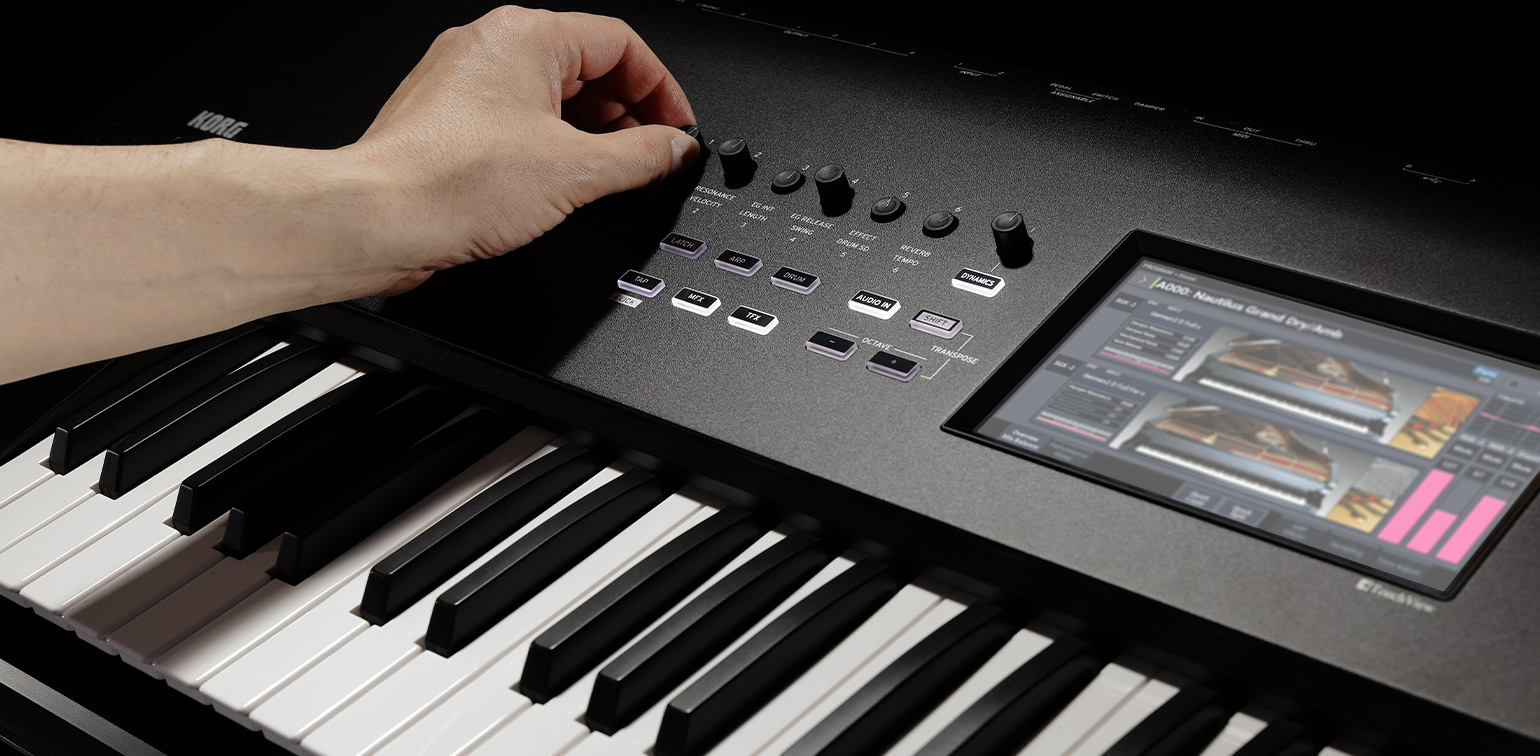
The DYNAMICS knob makes delicate expression possible
With the DYNAMICS knob, you can instantly control the changes in volume and tone in response to how hard you play the keyboard (velocity); and you can customize this knob in real time to match the keyboard playing feel required for each style and song. Even when playing the same sound, you can turn this knob to get the feeling of playing a completely different sound. By finding just the right setting for your playing style, you’ll uncover even more of the possibilities that the NAUTILUS offers.
When you activate the DYNAMICS knob and turn it to the left, the keyboard responds more softly to your playing, giving you a wide range of dynamics. This allows for delicate, expressive playing when accompanying a piano solo or vocals, which directly reflects the dynamics of your performance. On the other hand, turning the knob to the right gives a stronger, more flat dynamic response. This brings out the sound when you’re playing in a band or ensemble, which works best when performing with a more even feel.
Make intuitive changes to sounds with the Realtime knobs
The six RT (real-time) knobs at the top left of the panel give you direct control over changes to the PROG and COMBI sounds. A variety of functions are assigned to each knob that lets you enjoy making changes to sounds, such as the filter cutoff and effect depth, the gate time, tempo and swing of the arpeggiator or drum track, the type of snare drum and more. In COMBI mode, you can group timbres and control their levels with the knobs. Further, you can press these knobs into the panel to lock them in place, preventing them from being accidentally changed while you’re playing. For instance, you could use this to enable only the knobs you often use onstage and push the ones in that you do not need.
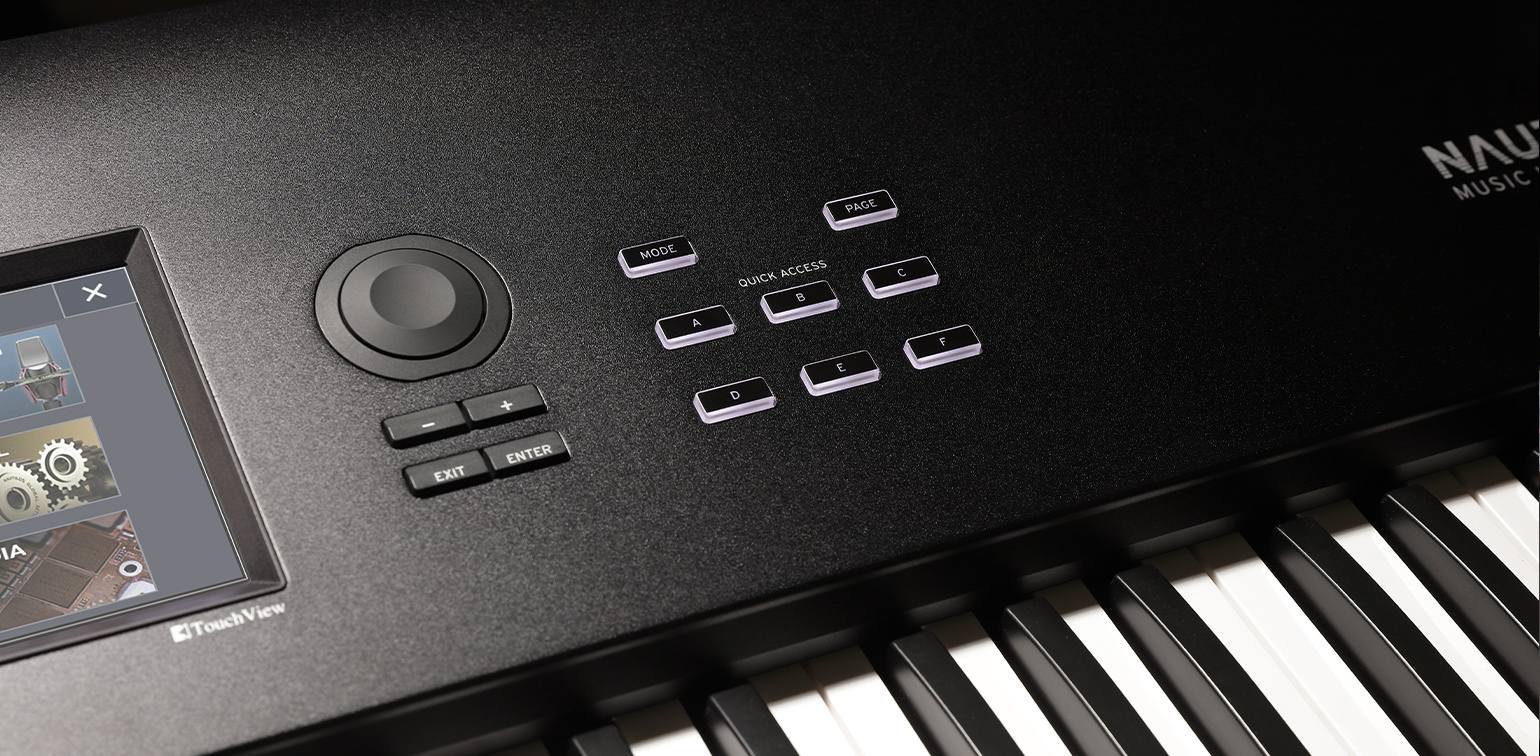
A user interface designed for easy operation
For the NAUTILUS, we have completely rethought the user interface, considering that panel controls tend to become denser as more functions are added. The interface of the NAUTILUS lets users find just the things they’re looking for once they understand the principles.
The MODE button lets you see what you’ve selected in each mode on a single screen, from PROG and COMBI to the set list, sampling, sequence and global modes. Each mode has tabs for each function, and the PAGE buttons offer more detailed editing with consistent operations. With the user-friendly navigation of the NAUTILUS, you can press the MODE button at any time to return to the start if you get lost. A dark mode is available for the display, using black as the primary color to reduce eye fatigue.
Six quick access buttons are also available as shortcut buttons. The NAUTILUS further offers four templates as a continuation of the previous user-friendly features, which can be used to select modes like PROG and COMBI, as transport buttons for sequencer playback and recording and so on. You can also select your own settings as you like. What’s more, you can freely assign functions you frequently use and save them in one of four sets.
Convenient arpeggiator and drum track functions
Four scenes of arpeggio patterns and drum track sets are made available that perfectly match each PROG and COMBI preset sound. These are useful for switching between scenes while they’re played, for use when improvising during performance, or for expanding your vision when composing music starting from a sound.
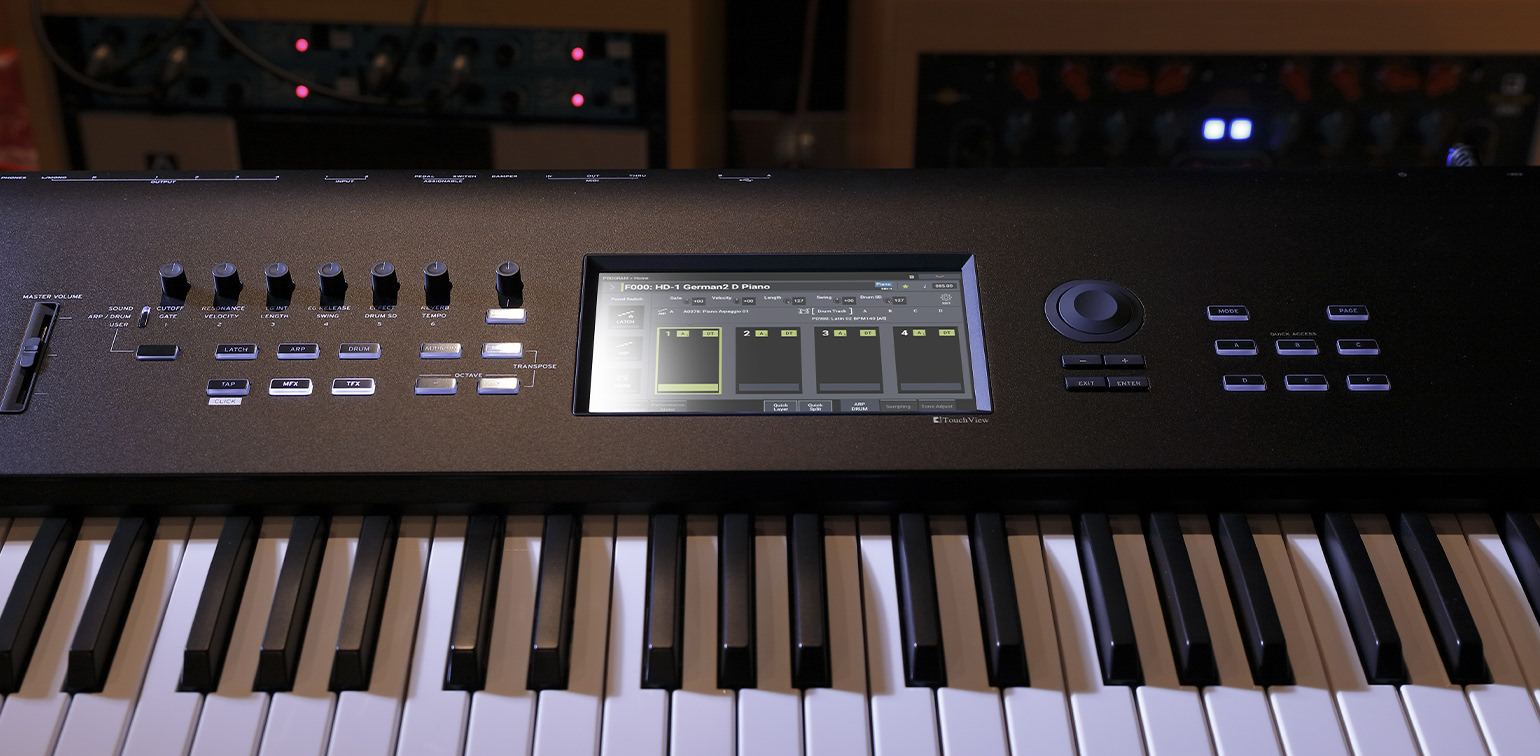
Color TouchView Display
The nerve center of the NAUTILUS is KORG’s enormous eight-inch (800 x 480 pixel) WVGA color TouchView display.
In addition to simply selecting a sound or choosing a parameter with the touch of a finger, the enhanced Touch-Drag ability allows more detailed control of parameter values. Interactive instruments and panel graphics provide the ability to do everything from adjusting the lid of a grand piano to connecting patch cable on a semi-modular synthesizer model.
The TouchView display also hosts a convenient new Search Function, allowing you to search for (and preview) sounds based on their titles.
Set list mode that demonstrates its power in live performances
NAUTILUS can organize all of the resources you need to get through a song—or a set—using the Set List mode. Using the Set List mode, the TouchView display can host 16 color-coded touch-screen buttons; each one can instantly call up the appropriate Preset, Combination, or Sequence—regardless of mode!
You can also select different button colors, such as when you want to change the colors within a song while playing live. This is a powerful feature for situations that require quick and accurate control. The Set List mode even adds a nine-band graphic EQ, allowing the overall tone to be tweaked to match the venue.
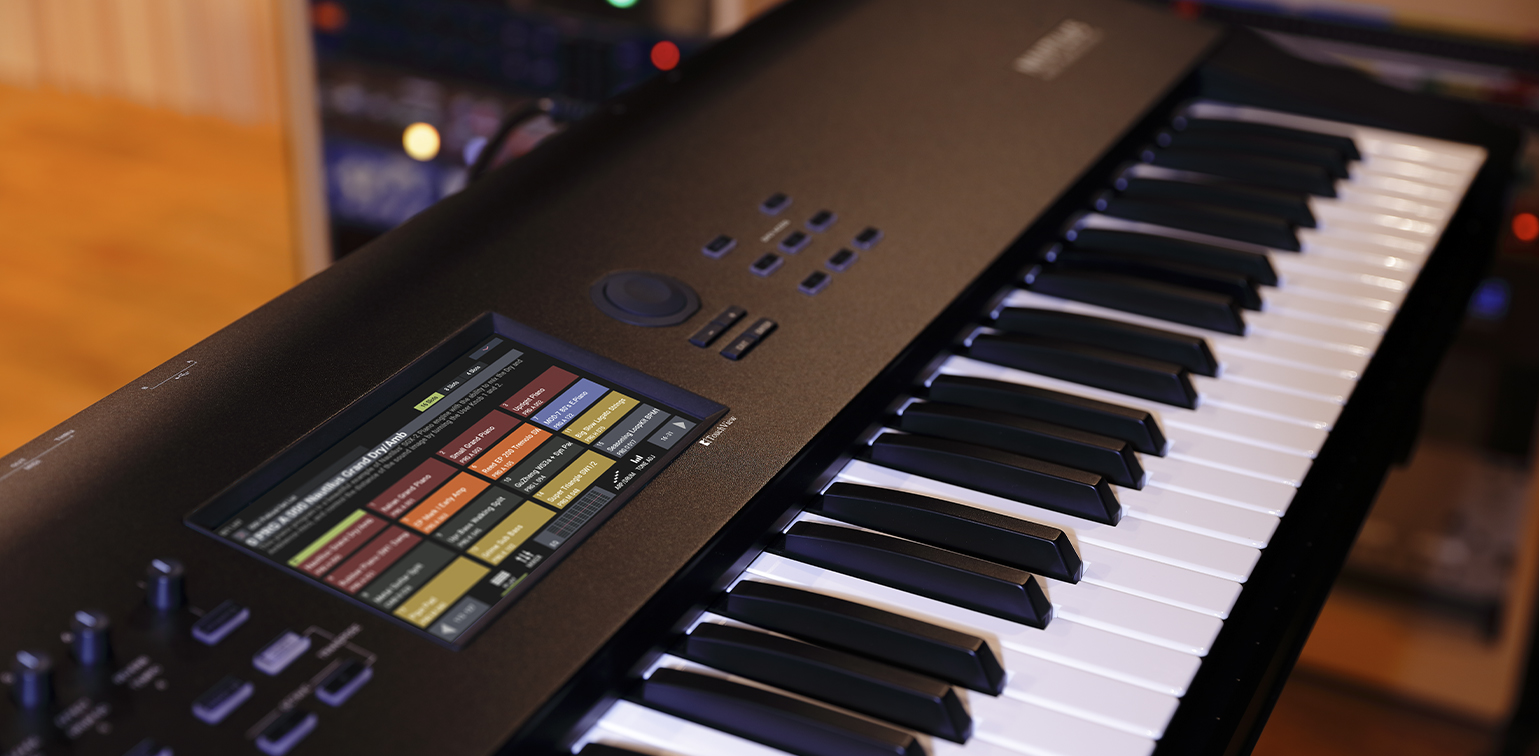
Open Sampling System
Using KORG’s Open Sampling System, NAUTILUS can quickly sample an external audio source, regardless of whether NAUTILUS is in the Program, Combination, or Sequencer modes. The Open Sampling Mode can even resample the performance of the NAUTILUS itself. The user sample bank, which extends the convenience of the EXs sample library to user samples, allows custom samples to be loaded and played, taking advantage of the gigantic SSD capacity.
AIFF, WAV, SoundFont 2.0, and AKAI S1000/3000 format samples can be loaded into memory via USB memory. Additionally, you can use a USB Ethernet adapter to exchange large amounts of sample data with your computer at high speed. Instruments or samples that you’ve previously created on your PC can be used to construct a music production setup based on just the NAUTILUS itself.
16-Track MIDI Sequencer / 16-Track Audio Recorder
NAUTILUS features a sequencer/recording section that offers both 16 MIDI tracks plus 16 audio tracks; a great resource for putting together a dazzling performance or a brilliant production. MIDI sequencing makes it easy to capture ideas, inspiration, and pro-quality phrases using the Drum Track, or RPPR (Realtime Pattern Play/Recording) functions.
The 16-track audio recorder simultaneously captures up to four tracks of 16-bit/24-bit uncompressed data at a sampling rate of 48 kHz. Play along with recorded tracks, add effects, and then resample the NAUTILUS itself and place the resampled WAV files directly in a track. When polishing your tracks, feel free to use mixer automation and editing functions such as copy, paste, and normalize to get the results you want.
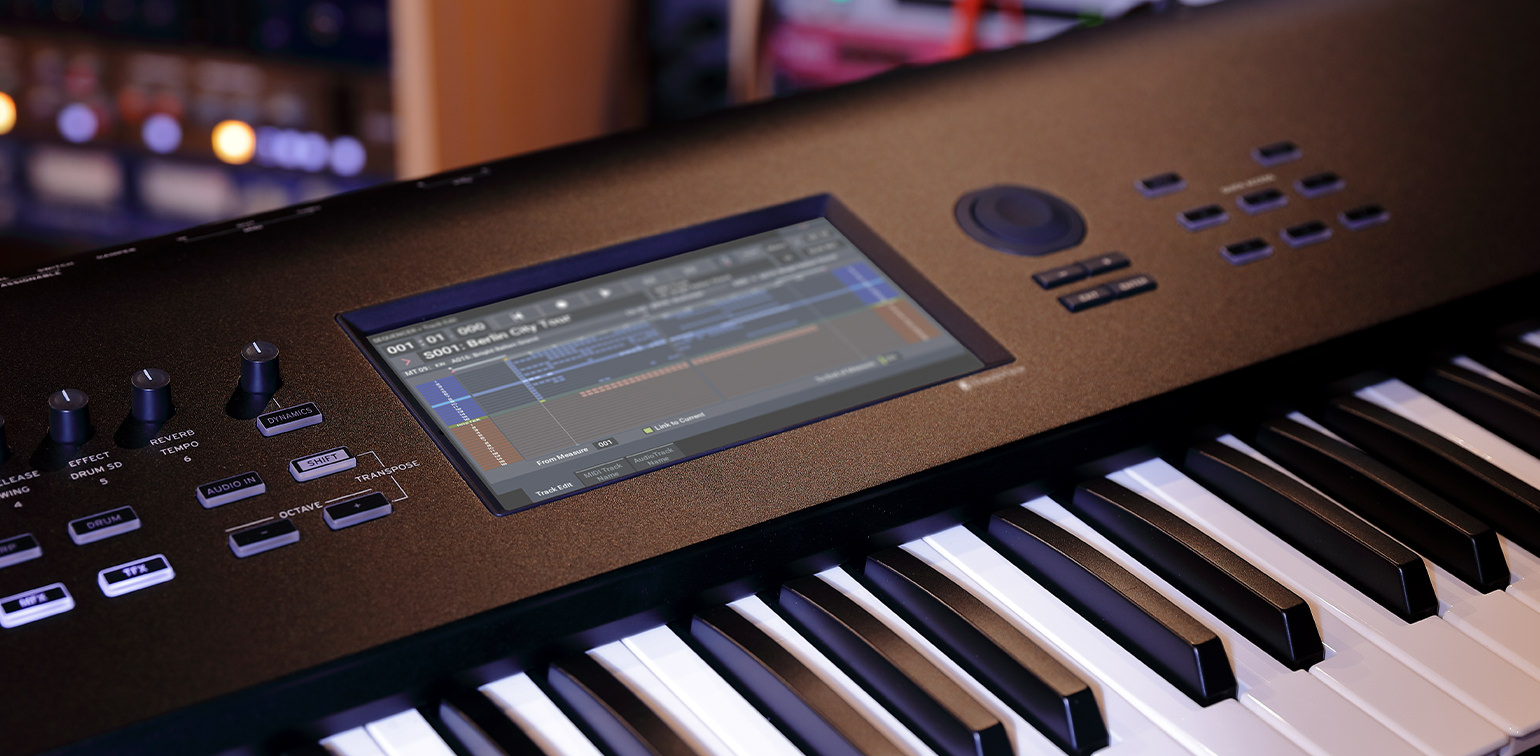
NATILUS provides 16 internal effects to add impact to your sonic creations. Each of the 12 Insert effects can be applied to individual or multiple timbres in a combination, or to individual or multiple tracks of the sequencer. In addition, two Master effects can be applied to sends 1/2, and two Total effects can be applied to all tracks at the final stage of the sound.
A separate three-band EQ is provided for every timbre, for every sequencer track, and for every audio track for adjusting subtle tonal balances or for creatively modifying the overall sound.
You must be logged in to post a review.
Related products
-
Roland XPS-10 (Black)
₹63,344.00Original price was: ₹63,344.00.₹55,000.00Current price is: ₹55,000.00.Add to cart- Pro performance keyboard with a diverse selection of high-quality sounds for live and studio playing
- Includes a wide range of ethnic sounds, plus a User Scale function for creating regional tunings
- Sample Import function allows users to import and play custom sounds from the keyboard
- Six Audio Pads for triggering audio files, loops, and sound effects via USB memory or built-in XPS-10 rhythms
- Powerful built-in effects—three MFX (each with 78 types) plus global reverb and chorus
- Intuitive user interface, designed for live performance
- Quick-access buttons for favorite sounds and split, layer, octave shift, and transpose functions
- Sound Modify section for real-time sound shaping and level control
- Arpeggio function with a large selection of adjustable parameters
- USB Computer port provides MIDI communication with popular music software
- Compact, durable design with lightweight body (4 kg) for easy transport
-
Korg, Arranger Keyboard PA-600
₹104,000.00Original price was: ₹104,000.00.₹95,000.00Current price is: ₹95,000.00.Read more- Enhanced RX (Real eXperience) and DNC (Defined Nuance Control) sound engine offers improved realism and vivid sound.
- Massive internal Factory PCM – plus up to 96 MB of user PCM data – provides an extraordinarily powerful wave memory, delivering amazingly high quality sounds.
- Two assignable switches and a four-way joystick ensure total control for the many available levels of sound articulation (DNC).
- Two versions of Pa600 are available: International and Quarter Tone button variations. Both feature elegantly designed and compact cabinet including a pristine amplification system.
- Large, bright, backlit TouchView™ color TFT display (800×480).
- Easy layout and intuitive graphical interface with new Search function for easy retrieval of any musical resource or file. New resource selection feature with copy/paste, rename and delete.
- New resource selection feature with copy/paste, rename and delete.
- Over 360 factory Styles, each including three Intros/Endings, four variations and four Fill In + Break, plus ten Favorite and three User banks for storage of your favorite customized or user created Styles.
- Enhanced Guitar Mode 2 for even more realistic guitar parts, plus synchronized pads.
- Chord Sequencer function that can record any chord progression on-the-fly.
- Improved General Midi set for Standard Midi Files, compatibility with popular lyric formats including graphical (+G), plus Text Viewer, Marker and Score.
- MP3 player with Transpose and Tempo Change.
- 4 Stereo Master Effects (125 FX algorithms).
- Fully programmable SongBook database based on Styles, SMF, karaoke, and MP3, with instant recall of any song setting and user-definable custom lists.
- Localized Pa600 and Pa600QT data (sold separately) provides Sounds and Styles relevant to specific countries and regions.
-
Korg, Arranger Keyboard PA-1000
₹260,000.00Original price was: ₹260,000.00.₹200,000.00Current price is: ₹200,000.00.Add to cart61 semi-weighted keys (C2 – C7) with velocity and aftertouchSystem
Upgradable operating system, Multitasking, Load while playSound Generator
EDS-X (Enhanced Definition Synthesis – eXpanded)
Filters with resonance, 3-band EQ on each SoundPolyphony
128 voices, 128 oscillatorsEffects
- Accompaniment/Song:
- 2 insert effects; 2 master effects (148 types)
- Keyboard Sounds
- 1 insert effect; 2 master effects (148 types)
- Final mastering effects
- Limiter, Master EQ
- Voice Processor
- EQ, Compressor, Gate, 3-voice Harmonizer (or Double), 2 x FX. Harmonizer, Double: Technology by TC•Helicon®
- Presets
- More than 30 Factory, 64 User
- Guitar Processor
- 3 x FX. Presets: 45 Factory, 64 User
Sounds / Drum Kits
- Factory
- More than 1,750 Factory Sounds, including two multilayer Stereo Pianos with damper and body resonance, GM/XG sound sets and 107 Drum Kits
- User
- 512 Sounds, 256 Drum Kits
- Digital Drawbars
- 9 footages, percussion, key on/off, leakage, rotary speaker effect
- DNC (Defined Nuance Control) Technology, Natural Ambience Drums Full Sounds/Drum Kits editing
Sampling
- User PCM Sample memory
- 300 MB compressed (equivalent to 600 MB linear data)
- Loads KORG, WAV, AIFF and SoundFont™ formats
Saves KORG, WAV and AIFF formats
Full Edit, Time Slice, Sampling
Styles
- Factory
- More than 430 Factory Styles, freely reconfigurable sets
- User
- 1,152 locations, including User and Direct banks
- Eight Accompaniment tracks, 4 Keyboard Sets, 4 Pads per Style; Style Settings (Sounds and Arranger parameters) on each Style
Guitar Mode 2, Parallel and Fixed NTT (Note Transposition Table)
Style/Pad Record with Step Record, Track and Event Edit
Style Creator Bot (MIDI Song to Style Converter)
- Style controls
- 3 Intros, 4 Variations, 4 Fills, Break, 3 Endings, Synchro Start, Synchro Stop, Tap Tempo/Reset, Bass Inversion, Auto Fill, Manual Bass, Memory, Accompaniment Mute, Drum Mapping, Snare & Kick Designation, Style to Keyboard Set Mode
Chord Sequencer
- Chord Sequence recorder and player in Style Play mode
Chord Sequences can be saved to Style and SongBook Entries
- Edit functions
- Delete, Copy from Style/SongBook, Import/Export from/to SMF
Keyboard Set Library
- Memorize Keyboard Sound settings
- Factory
- More than 300 Keyboard Sets, freely reconfigurable
- User
- 864 locations, including User and Direct banks
- ‘My Setting’ special Keyboard Set
KAOSS FX
Automatic MIDI FX generator
More than 65 Factory PresetsSong Play
- Patented XDS Crossfade Dual Sequencer Player with X-Fader control
- Supported formats
- MID, KAR, MP3+Lyrics, MP3+G
- Two Players with separate Select, Start/Stop, Home, Rewind and Fast Forward controls
Lyrics, Score, and Chord data can be displayed on screen, or on an external video monitor
Markers with Add, Delete, Edit and Loop functions
Jukebox function
MP3 Player / Recorder
Double MP3 Player and MP3 Recorder
Transpose (+6/-5 semitones), Tempo change (±30%)
Vocal Remover
Records MP3 files, including Styles, MIDI Songs, MP3 Songs, Keyboard Sounds, Pads, Microphone, Guitar, Effects, KAOSS EffectsSequencer
Quick Record (Backing Sequence), Multitrack and Step Record functions
Full-featured sequencer, 16 tracks, Up to 200,000 events, SMF (MID) native formatSongBook
Fully programmable music database, based on Styles, MIDI Songs (MID and KAR files), MP3 Songs, with automatic selection of Style Play and Song Play modes
User definable Set Lists, with Entries selectable from the control panel
Filtering and sorting optionsCompatibility
- Pa-Series models
- Styles, Performances/Keyboard Sets, Programs/Sounds, Songs, SongBook Entries, Pads
- ‘i-Series’ models
- Styles
Pads
Four Assignable Pads + Stop buttons
Pad Record functionControls
Master Volume, Fade In/Out, Keyboard-Acc/Song Balance, Ensemble, Octave Transpose, Master Transpose, Quarter Tone and Arabic Scale memorized inside Keyboard Sets, Joystick, Audio In Volume, Mic FX Level, Harmony/Double On/Off, Mic/Guitar Preset, Audio In Mute ,2 Assignable Knobs, 3 Assignable Switches, Tempo +/-, Tempo Lock, Metronome On/Off, Dial, Search, Shift, Chord Scan (Lower, Upper), Split, Track Select, Record
Virtual Quarter Tone SubScale Keypad, 4 x Scale PresetsControl Inputs
Damper pedal (supports half-pedaling with the optional DS-1H pedal)
Assignable pedal/switchAudio Inputs
- Line (Left/Right)
- 1/4” jacks, +20dBm, 12k Ohm
- Mic/Guitar (Left)
- 1/4” jack, with Gain control (0 — +40dB)
12k Ohm (Mic) / 500k Ohm (Guitar)
Audio Outputs
- Left/Right
- 1/4” jack, +21dBm, 0.003% THD+N@+18dBm
- Headphone output
- 1/4” jack, 16-200 Ohms (50 Ohms suggested)
Speaker System
- Amplification
- 2 x 33 W
- Speakers
- 2 x 100 mm woofers in bass reflex box, 2 x 25 mm dome tweeters
MIDI
- IN, OUT
- Standard MIDI connectors
- USB to MIDI using the USB ports
Eight user definable MIDI Setups
USB
- Type A
- HOST, for memory and controllers x 2 (front/rear)
- Type B
- DEVICE, for personal computers and tablets x 1 (rear)
- 2.0 Hgh-Speed connections (480 Mbit/s).
Storage
- Internal memory
- 960 MB
- USB external drives (drive not included)
microSD card (not included); rear panel slot with plastic cover
Display
7” Wide capacitive color TouchView™ TFT display – Manual tilt systemVideo Out
HDMI connector
Clock
Internal System ClockPower Consumption
100–240 Volts, 50/60 Hz, 25 Watt normal / 0.3 Watt in standbyDimensions (W x D x H)
1030 x 378.3 x 133 mm / 40.55″ x 14.89″ x 5.36″ (without music stand; height with music rest: 355.8 mm / 14”)Weight
10.75 kg / 23.7 lbsIncluded Items
AC Power Cable, Music Stand, Quick Guide manualAccessories
EXP-2 Foot Controller, XVP-10 Expression/Volume Pedal
DS-1H Damper Pedal (supports half-pedaling)
PS-1, PS-3 Pedal Switch
VOX V860 volume pedal -
Yamaha Genos Digital Workstation
₹399,990.00Original price was: ₹399,990.00.₹344,000.00Current price is: ₹344,000.00.Add to cartGenos Dimensions Width 1,234 mm (48-9/16″) Height 138 mm (5-7/16″) Depth 456 mm (17-15/16″) Weight Weight 13.0 kg (28 lb, 11 oz) Keyboard Number of Keys 76 Type Organ (FSX), Initial Touch/Aftertouch Touch Response Normal, Easy1, Easy2, Soft1, Soft2, Hard1, Hard2 Other Controllers Joystick Yes Control Knobs 6 Live Control knobs (Assignable) Sliders 9 Live Control sliders (Assignable), Cross Fader Art. Switches 3 Display Type Main Display : TFT Color Wide VGA LCD | Sub Display: OLED (Live Control view) Size Main Display : 800 x 480 dots (9 inch) | Sub Display: 589 x 48 dots Touch Screen Main Display : Yes Language Main Display : English, German, French, Spanish, Italian | Sub Display: English Panel Language English Tone Generation Tone Generating Technology AWM Stereo Sampling, AEM technology Polyphony Number of Polyphony (Max.) 256 (max.) (128 for Preset Voice + 128 for Expansion Voice) Preset Number of Voices 1,652 Voices + 58 Drum/SFX Kits Featured Voices 10 Revo! Drums/SFX, 76 Ensemble, 390 Super Articulation!, 75 Super Articulation2!, 82 MegaVoice, 40 Sweet!, 81 Cool!, 160 Live!, 24 Organ Flutes! Compatibility XG Yes (for Song playback) GS Yes (for Song playback) GM GM (for Song playback) GM2 GM2 (for Song playback) Part Right 1, Right 2, Right 3, Left Capacity Voice Yes (approx.3.0 GB) Style&Voice Set Yes (Internal Memory) Types Reverb 59 Preset + 30 User Chorus 107 Preset + 30 User DSP Variation: 358 Preset(with VCM) + 30 User | Insertion 1–28: 358 Preset(with VCM) + 30 User Master Compressor 5 Preset + 30 User Master EQ 5 Preset + 30 User Part EQ 28 Parts Vocal Harmony Number of Presets Vocal Harmony: 54 | Synth Vocoder: 20 Number of User Settings 60 * The number is the total of Vocal Harmony and Synth Vocoder Vocal Effect Mic Effect: Noise Gate, Compressor, 3 Band EQ | Vocal Effect: 23 Preset Number of Preset Styles 550 Featured Styles 491 Pro, 39 Session, 10 Free Play, 10 DJ Fingering Single Finger, Fingered, Fingered On Bass, Multi Finger, AI Fingered, Full Keyboard, AI Full Keyboard Style Control INTRO x 3, MAIN VARIATION x 4, FILL x 4, BREAK, ENDING x 3 Other Features One Touch Setting (OTS) 4 for each Style Chord Looper Yes Style Section Reset Yes Compatibility Style File Format (SFF), Style File Format GE (SFF GE) Preset Number of Multi Pad Banks 448 Banks x 4 Pads Audio Audio Link Yes Preset Number of Preset Songs 9 Demo Songs, 11 Preset Songs Recording Number of Tracks 16 Recording Function Quick Recording, Multi Track Recording, Step Recording Compatible Data Format Playback SMF (Format 0, Format 1) , XF Recording SMF (Format 0), approx. 3 MB per Song Audio Recorder/Player Playback WAV (44.1 kHz, 16 bit, stereo), MP3 (44.1 kHz, 64/96/128/256/320 kbps, stereo) Recording WAV (44.1 kHz, 16 bit, stereo), approx. 0.8 GB (80 minutes) per Song Time Stretch Yes Pitch Shift Yes Vocal Cancel Yes Voices Harmony/Echo Yes Arpeggio Yes Panel Sustain Yes Mono/Poly Yes Styles Style Creator Yes OTS Information Yes Multi Pads Multi Pad Creator Yes Registration Number of Buttons 10 Control Registration Sequence, Freeze Playlist Number of Records 2,500 (max.) Records per Playlist file Songs Score Display Function Yes Lyrics Display Function Yes Search Registration Bank Overall Controls Metronome Yes Tempo Range 5 – 500, Tap Tempo Transpose -12 – 0 – +12 Tuning 414.8 – 440.0 – 466.8 Hz (approx. 0.2 Hz increments) Octave Button Yes Scale Type 9 Types Sub Scale Setting Yes Miscellaneous Direct Access Yes Text Display Function Yes Wallpaper Customization Yes Display Out Yes (by using a commercially USB display adaptor) * For a list of compatible devices, access the “Yamaha Downloads” website. *Genos generates a 800 x 600 size image for external display. The size of Genos main display is 800 x 480, so there will always be blank areas at the top and bottom of the image. Storage Internal Memory Yes (approx. 58 GB) External Drives USB flash drive Connectivity Headphones Standard stereo phone jack (PHONES) FOOT PEDAL 1 (SUSTAIN), 2 (ART.1), 3 (VOLUME), Function assignable Microphone Yes (Combo Jack) , Phantom Power (+48V) available MIDI MIDI A (IN/OUT) , MIDI B (IN/OUT) AUX IN L/L+R, R DIGITAL OUT Yes (coaxial) LINE OUT MAIN (L/L+R, R) , SUB (1, 2) , SUB (3, 4 / AUX OUT) USB TO DEVICE Yes (x 3) USB TO HOST Yes LAN Yes (*) , Standards: IEEE802.11b/g/n (IEEE802.11n 5GHz: not compatible) *May not be included, depending on your area. Check with your Yamaha dealer.








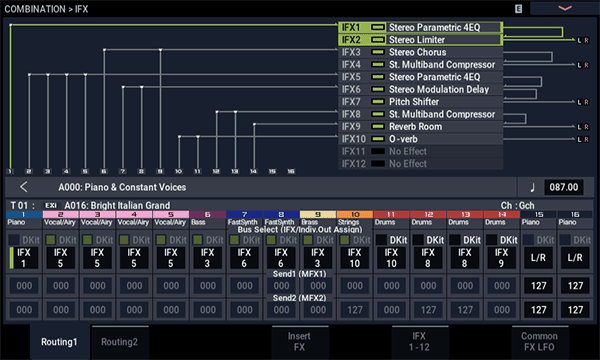
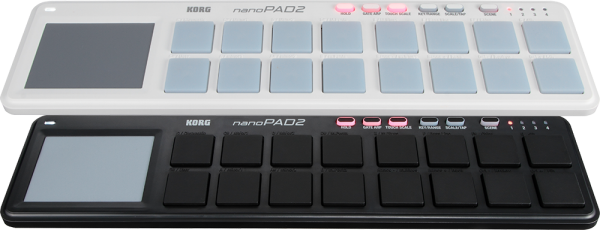











Reviews
There are no reviews yet.